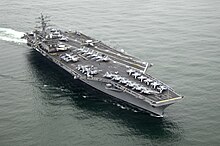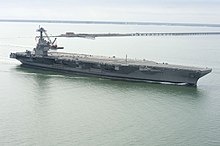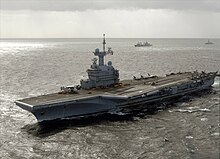
An aircraft carrier is a warship that serves as a seagoing airbase, equipped with a full-length flight deck and facilities for carrying, arming, deploying, and recovering aircraft. Typically, it is the capital ship of a fleet, as it allows a naval force to project air power worldwide without depending on local bases for staging aircraft operations. Carriers have evolved since their inception in the early twentieth century from wooden vessels used to deploy balloons to nuclear-powered warships that carry numerous fighters, strike aircraft, helicopters, and other types of aircraft. While heavier aircraft such as fixed-wing gunships and bombers have been launched from aircraft carriers, these aircraft have not landed on a carrier. By its diplomatic and tactical power, its mobility, its autonomy and the variety of its means, the aircraft carrier is often the centerpiece of modern combat fleets. Tactically or even strategically, it replaced the battleship in the role of flagship of a fleet. One of its great advantages is that, by sailing in international waters, it does not interfere with any territorial sovereignty and thus obviates the need for overflight authorizations from third-party countries, reduces the times and transit distances of aircraft and therefore significantly increases the time of availability on the combat zone.
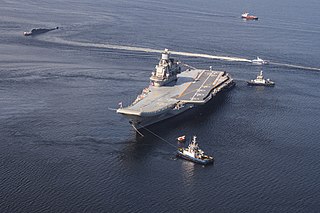
The Kuznetsov-class aircraft carrying cruiser, Soviet designation Project 1143.5, is a class of STOBAR aircraft carriers operated by the Russian and Chinese navies. Originally designed for the Soviet Navy, the Kuznetsov-class ships use a ski-jump for launching high-performance jet aircraft and arrestor gears for landing. The design represented a major advance in Soviet fleet aviation over the Kiev-class carriers, which do not have full-length flight deck and could only launch VSTOL aircraft. The Soviet Union's classification for the class was as a heavy aircraft-carrying cruiser, which permits the ships to transit the Turkish Straits without violating the Montreux Convention. However, the Chinese variants are classified as aircraft carriers.

An electromagnetic catapult, also called EMALS after the specific US system, is a type of aircraft launching system. Currently, only the United States and China have successfully developed it, and it is installed on the Gerald R. Ford-class aircraft carriers and the Chinese aircraft carrier Fujian. The system launches carrier-based aircraft by means of a catapult employing a linear induction motor rather than the conventional steam piston.

The Queen Elizabeth-class aircraft carriers of the United Kingdom's Royal Navy consists of two vessels. The lead ship of her class, HMS Queen Elizabeth, was named on 4 July 2014 in honour of Elizabeth I and was commissioned on 7 December 2017. Her sister ship, HMS Prince of Wales, was launched on 21 December 2017, and was commissioned on 10 December 2019. They form the central components of the UK Carrier Strike Group.

The Gerald R. Ford-class nuclear-powered aircraft carriers are currently being constructed for the United States Navy, which intends to eventually acquire ten of these ships in order to replace current carriers on a one-for-one basis, starting with the lead ship of her class, Gerald R. Ford (CVN-78), replacing Enterprise (CVN-65), and later the Nimitz-class carriers. The new vessels have a hull similar to the Nimitz class, but they carry technologies since developed with the CVN(X)/CVN-21 program, such as the Electromagnetic Aircraft Launch System (EMALS), as well as other design features intended to improve efficiency and reduce operating costs, including sailing with smaller crews. This class of aircraft carriers is named after former U.S. President Gerald R. Ford. CVN-78 was procured in 2008 and commissioned into service on 22 July 2017. The second ship of the class, John F. Kennedy (CVN-79), is scheduled to enter service in 2025.

STOBAR is a system used for the launch and recovery of aircraft from the deck of an aircraft carrier, combining elements of "short take-off and vertical landing" (STOVL) with "catapult-assisted take-off, barrier-arrested recovery" (CATOBAR).

An aircraft catapult is a device used to allow aircraft to take off in a limited distance, typically from the deck of a vessel. They can also be installed on land-based runways, although this is rarely done. They are usually used on aircraft carriers as a form of assisted take off.
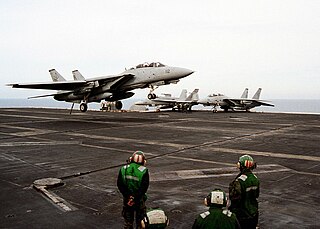
An arresting gear, or arrestor gear, is a mechanical system used to rapidly decelerate an aircraft as it lands. Arresting gear on aircraft carriers is an essential component of naval aviation, and it is most commonly used on CATOBAR and STOBAR aircraft carriers. Similar systems are also found at land-based airfields for expeditionary or emergency use. Typical systems consist of several steel wire ropes laid across the aircraft landing area, designed to be caught by an aircraft's tailhook. During a normal arrestment, the tailhook engages the wire and the aircraft's kinetic energy is transferred to hydraulic damping systems attached below the carrier deck. There are other related systems that use nets to catch aircraft wings or landing gear. These barricade and barrier systems are only used for emergency arrestments for aircraft without operable tailhooks.

The Electromagnetic Aircraft Launch System (EMALS) is a type of electromagnetic catapult system developed by General Atomics for the United States Navy. The system launches carrier-based aircraft by means of a catapult employing a linear induction motor rather than the conventional steam piston. EMALS was first installed on the lead ship of the Gerald R. Ford-class aircraft carrier, USS Gerald R. Ford.
As of 2024, the Chinese People's Liberation Army Navy (PLAN) has two active carriers, the Liaoning and Shandong, with the third, Fujian, currently undergoing sea trials. A fourth carrier, currently called "Type 004" and featuring nuclear propulsion, might be under construction. Wang Yunfei, a retired PLA Navy officer and other naval experts projected in 2018/2019 that China might possess five or six aircraft carriers by the 2030s.

A carrier-based aircraft is a naval aircraft designed for operations from aircraft carriers. Carrier-based aircraft must be able to launch in a short distance and be sturdy enough to withstand the abrupt forces of launching from and recovering on a pitching deck. In addition, their wings are generally able to fold up, easing operations in tight quarters.
INS Vishal, also known as Indigenous Aircraft Carrier 3 (IAC-3), is a planned aircraft carrier to be built by Cochin Shipyard Limited for the Indian Navy. It is intended to be the third aircraft carrier to be built in India after INS Vikrant (IAC-1) and another Vikrant-class aircraft carrier, provisionally called (IAC-2). The proposed design of this class will be a new design, featuring significant changes from Vikrant, including an increase in size and displacement. An Electromagnetic Aircraft Launch System (EMALS) CATOBAR system is also under consideration. Its name Vishal means 'grand' in Sanskrit.
Aircraft have different ways to take off and land. Conventional airplanes accelerate along the ground until reaching a speed that is sufficient for the airplane to takeoff and climb at a safe speed. Some airplanes can take off at low speed, this being a short takeoff. Some aircraft such as helicopters and Harrier jump jets can take off and land vertically. Rockets also usually take off vertically, but some designs can land horizontally.

The Advanced Arresting Gear (AAG) is a type of arresting gear developed by General Atomics for the U.S. Navy's newest Gerald R. Ford-class aircraft carriers. It was deployed in 2017 on the lead ship of the class, the USS Gerald R. Ford (CVN-78).

Fujian, named after Fujian province, is the third aircraft carrier of the Chinese aircraft carrier programme and the first of the Type 003 class. It is China's first indigenously designed carrier, and its first capable of catapult-assisted take-offs (CATOBAR); previous Chinese carriers used ski-jumps (STOBAR).

In aviation, a ski-jump is an upward-curved ramp that allows aircraft to take off from a runway that is shorter than the aircraft's required takeoff roll. By forcing the aircraft upwards, lift-off can be achieved at a lower airspeed than that required for sustained flight, while allowing the aircraft to accelerate to such speed in the air rather than on the runway. Ski-jumps are commonly used to launch airplanes from aircraft carriers that lack catapults.
The Type 076 landing helicopter dock is a planned class of amphibious assault ship for the Chinese People's Liberation Army Navy (PLAN). Compared to the similarly sized Type 075, the Type 076 is expected to have a CATOBAR system of electromagnetic catapult and arresting gears for operating light fixed-wing aircraft, likely unmanned combat aerial vehicles (UCAV).
Project Vixen is the name of a Royal Navy programme examining the use of fixed-wing unmanned aerial vehicles (UAVs) from its two aircraft carriers. The project likely draws its name from the de Havilland Sea Vixen, notable for being the Royal Navy's first two-seat carrier-based aircraft capable of supersonic flight.


